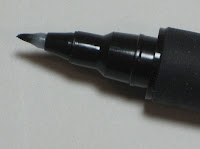 |
| 12/24/13 Platinum Carbon ink, watercolor, Fabriano hot press 140 lb. paper |
Before I started sketching, I used to read the Seattle Sketcher’s column every
Saturday in The Seattle Times and
think about how much fun it would be to peek inside his sketchbook. At that
time, I didn’t really know anyone who did that type of sketching (nor could I
imagine myself ever doing it), so it seemed like such a novelty to be drawing pictures
for a newspaper rather than photographing them.
Inspired by the Seattle Sketcher and compelled to finally draw,
I eventually joined Seattle Urban Sketchers (the Seattle chapter of the international organization Gabi founded),
met Gabi Campanario, and actually did peek into some of his sketchbooks. Today I
got the biggest peek yet – some literally larger than life – at “Drawn to
Seattle,” the Seattle Sketcher’s exhibit at the Museum of History and Industry (it continues through May 26,
2014).
If you’re a regular reader of Gabi’s column, the sketches
will be familiar. Even so, when you view the span of sketches from 2009 to the
present all at once, it’s surprising to see how much his style has changed and
matured over time. And I think some sketches in the exhibit were never
published in the paper or online, so even faithful readers will find something
new.
 |
| Sketches are presented in their original form and greatly enlarged. |
The MOHAI exhibit presents the sketches in a variety of ways
– the original pages taken right out of sketchbooks; intact sketchbooks mounted
and framed; full-size facsimiles that you can page through; and huge
reproductions on the walls. You can step back and see familiar “characters” larger
than life, or you can squint closely and try to read the tiny scribbles Gabi
wrote to himself in the margins as he interviewed sketch subjects. It’s also
fun to see the messy watercolor swatches at the bottom of sketches – all that
stuff that gets cropped out when published.
 |
| Familiar "characters" appear larger-than-life. |
The sketches are curated around themes like “Hidden Places,”
“Community Stories” and “Changing Landscapes.” As a Seattle native and lifelong
resident, I have seen most of the places shown in Gabi’s sketches, yet I am
always struck by how fresh those familiar scenes look when they are viewed through
his drawings. Even more, I am struck by the stories Gabi writes – the little
anecdotes his sketch subjects told him while he sketched, no doubt, and the
small yet important histories he recorded there, in words and pictures. I am
reminded that Gabi is not just a sketcher; he’s a journalist, and every sketch is
a story.
 |
| This case shows Gabi's sketch kit materials -- look at those messy palettes! |
Gabi’s spectacular exhibit is a fun and interactive space. Sketchbooks
are provided by MOHAI so that visitors can participate on the spot. Tips from
Gabi offer encouragement to sketcher wannabes: “Sketching is a form of visual documentation
that is accessible to all. No easels or expensive oil paints needed, just a pen
and a piece of paper and you are all set to get started.”
If I weren’t already an urban sketcher, seeing this exhibit
would inspire me to become one.
 |
| There's my sketchbook with the yellow cover! |
Shameless self-promotion: I will be among the “Urban
Sketchers in Residence” who will be leading mini-sketchcrawls at MOHAI every Saturday
1 – 3 p.m. through March 2014. And my own sketchbook, along with those of other
Seattle Urban Sketchers, is displayed in a case in the adjacent participative
gallery! (On Christmas Eve morning when we visited the exhibit, Greg and I
practically had the place to ourselves. But whenever I saw others coming
through, I wanted to shout, “There’s my sketchbook over there! I’m part of
this, too!”)
 |
| More sketchbooks contributed by members of Seattle Urban Sketchers. |












































